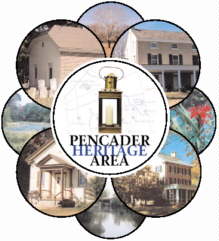 Two of the original grantees of the Welsh Tract, Evans and Davis, were Presbyterians. The first Pencader Presbyterian Church, in Glasgow, (originally called Aikentown) was built between 1701 and 1710 and conducted services in Welsh. Only twenty feet by thirty-six feet, it stood to the north of the present church, about where the Sexton's house now stands. After the Battle of Cooch's Bridge in 1777, the church served as a hospital for the British troops. The little frame building, with its steeply pitched roof and two doors and two windows in the front, was bought by Jacob Faris, Sr., one of the Trustees, and moved to the Southern part of the
village, where it served as a dwelling until it burned in 1913.
Two of the original grantees of the Welsh Tract, Evans and Davis, were Presbyterians. The first Pencader Presbyterian Church, in Glasgow, (originally called Aikentown) was built between 1701 and 1710 and conducted services in Welsh. Only twenty feet by thirty-six feet, it stood to the north of the present church, about where the Sexton's house now stands. After the Battle of Cooch's Bridge in 1777, the church served as a hospital for the British troops. The little frame building, with its steeply pitched roof and two doors and two windows in the front, was bought by Jacob Faris, Sr., one of the Trustees, and moved to the Southern part of the
village, where it served as a dwelling until it burned in 1913.
The second Pencader Church was built in 1782, using bricks burned on the nearby Jacob Faris farm. The same Mr. Faris planted the three magnificent Sycamore trees, locally known as Buttonwoods, which are still standing next to the third and present building. The largest measures sixteen feet in circumference and is more than one hundred feet high - truly a lordly tree. This third building, erected in 1852 at a cost of $5,000, was described as being,' as stiffly and uncompromisingly Protestant in its lines as were the backs of the men who caused it to be built.' Glasgow today lies along Route 40, which was originally called the
Pencader Presbyterian Church New Castle and Frenchtown Turnpike, chartered in 1809. Preserved in the old section of the village, in addition to the church, are a one room schoolhouse, some gracious eighteenth century homes, the Presbyterian Manse and the site of the original Aiken's Tavern, headquarters for General Howe's army in 1777. The area is suffering greatly from urban sprawl but the old Pencader Presbyterian Church, with its rows and rows of weathered tombstones, anchors the crossroads of
the village and invites you to ponder earlier times.
 While the Baptists were baptizing and the Presbyterians were debating whether or not it was decadent to install a stove for heat in the Glasgow church, up on Iron Hill, the Reverend Stephen Ott and his good wife Jane were battling the demon rum. By 1871 they had raised enough money to build the Ott Chapel which became a center for the temperance movement in Pencader Hundred. Mr. Ott brought in orators to plead the cause and for twenty-five years was president of the local Temperance Society. This must have truly been an uphill battle, for at this time the nearby iron ore pits were actively being worked by teams of lusty miners, many of them Irish. The Keeleys, O'Rourkes, McCloskeys, Megonigals, Sullivans and McDaniels are just a few of the families who contributed to the growth of Pencader Hundred.
While the Baptists were baptizing and the Presbyterians were debating whether or not it was decadent to install a stove for heat in the Glasgow church, up on Iron Hill, the Reverend Stephen Ott and his good wife Jane were battling the demon rum. By 1871 they had raised enough money to build the Ott Chapel which became a center for the temperance movement in Pencader Hundred. Mr. Ott brought in orators to plead the cause and for twenty-five years was president of the local Temperance Society. This must have truly been an uphill battle, for at this time the nearby iron ore pits were actively being worked by teams of lusty miners, many of them Irish. The Keeleys, O'Rourkes, McCloskeys, Megonigals, Sullivans and McDaniels are just a few of the families who contributed to the growth of Pencader Hundred.
The Otts persevered, kept the faith, and maintained the Campbellite (Disciples of Christ) faith in the midst of it all. Steven Ott died in 1875 and Jane in 1881. They are interred side by side in the chapel graveyard, their resting site marked by a unique double tombstone with the headstone and footstone connected by sidebars, also of stone. For those historians who enjoy trying to unravel local mysteries, the story concerning the nearby gravestone of the Davis brothers is worth researching. It reads: Davis, Enoc C. and Howard W., sons of Nathan and Carrie, Born Dec. 6, 1875, Died May 3,1882. It appears they were twins, who, as a result of some calamity, both passed away at the age of seven on the same day.
|
